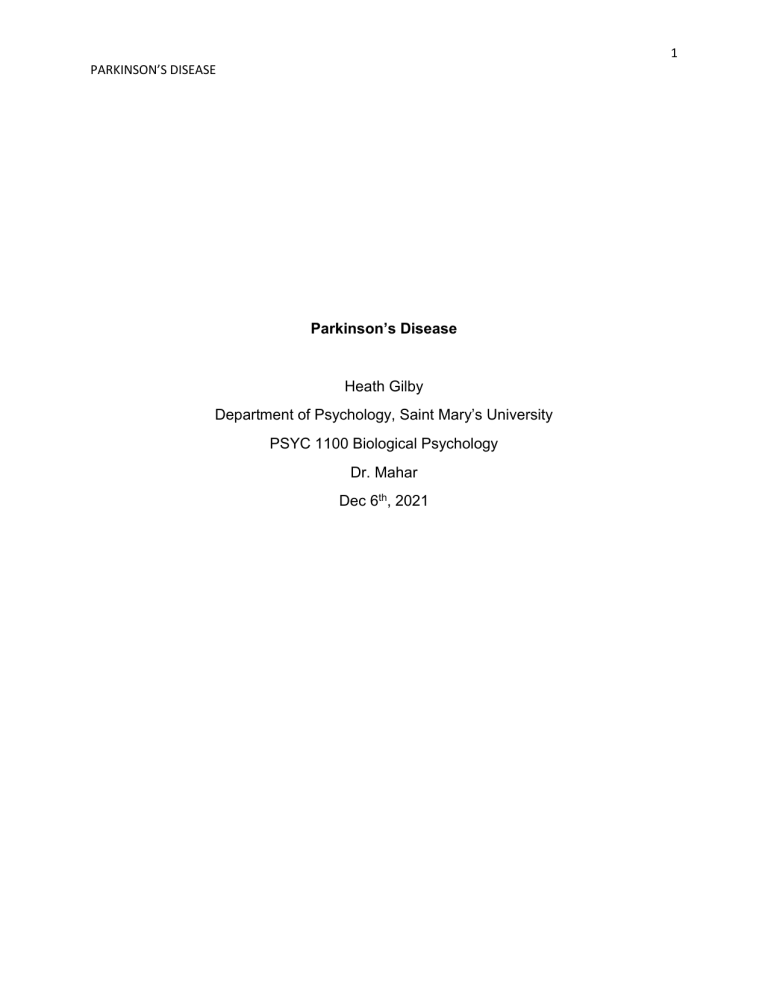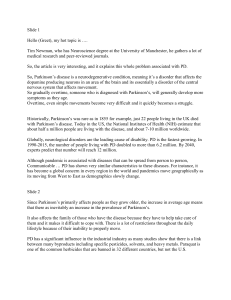
1 PARKINSON’S DISEASE Parkinson’s Disease Heath Gilby Department of Psychology, Saint Mary’s University PSYC 1100 Biological Psychology Dr. Mahar Dec 6th, 2021 2 PARKINSON’S DISEASE Parkinson’s disease is a neurodegenerative disorder that is caused by the slow degeneration of dopamine-producing nerve cells in the part of the brain that controls movement. This would be in the area of the brain called the substantia nigra. Those suffering with Parkinson’s disease will spend their final years living a life similar to being in a glass enclosure. They are completely capable of seeing outside, but they are unable to communicate with the rest of the world. Their emotions can't be expressed by facial expressions, and speaking becomes difficult, if not impossible, as their condition worsens. Men and women of all ethnicities and geographical areas make up this group, which accounts for one percent of the world's population over the age of 50. Many iconic individuals such as the “People’s Champion” Muhammad Ali or Back to the future star Michael J. Fox have dealt with the terrible disease that we call Parkinson’s disease and they have showcased their struggles. Their struggles have raised an incalculable amount of awareness for this disease as the race for a cure and better treatments continues. Despite the fact that Parkinson’s disease has been around for almost as long as recorded history, no cause or cure has yet to be discovered. Medications can alleviate symptoms and extend life, but they can't stop the disease from progressing. Because practically all laboratory and radiographic tests are normal in Parkinson patients, diagnosis is solely based on clinical signs and symptoms. As a result, early detection is quite difficult. The fact that early indications of Parkinson’s disease can be mistaken for normal ageing or other diseases such as in Robin Williams case he was diagnosed with Parkinson’s but had Lewy body dementia. This complicates diagnosis even more. As a result, primary care physicians caring for the middle-aged and elderly must pay close attention to their patients' outer appearance and changes in mobility. 3 PARKINSON’S DISEASE History Parkinson’s disease is the second most common neurodegenerative disease in the world (Li & Le, 2017). According to the Parkinson’s Foundation there are more than 10 million worldwide that are living with Parkinson’s disease. Parkinson’s disease was first described as a neurological disorder in “An Essay on the Shaking Palsy” by James Parkinson in 1817. James Parkinson first called it “paralysis agitans” but it was later renamed after James Parkinson. Over the course of history Parkinson’s disease like symptoms have been described in mean ancient texts most notably as far back as texts such as the Old Testament of the Bible, which would have been around 2000-440BC (Li & Le, 2017). Even Leonardo da Vinci presented a detailed description of the shaking palsy as a combination of difficulty with voluntary movements and tremor. Parkinson’s disease like symptoms were described hundreds of years in many different texts by many people. Edouard Brissaud in 1899 first suggested the origin of where Parkinson’s disease originated from, which was a damaged substantia nigra (Li & Le, 2017). Oleh Hornykiewicz found that patients with Parkinson’s disease had lower levels of dopamine (Li & Le, 2017). In 1961, Andre Barbeau leva-dopa was given to patients and that seemed to alleviate some symptoms. In 1987, Alim-Louia Benabid introduced Deep brain stimulation for treating the tremor. In 1997, Mihael Polymeropoulos the protein asynuclein was found to be the first causal gene of Parkinson’s disease (Li & Le, 2017). There are over 20 genes and loci that are related to Parkinson’s disease. Over the recent years it has been found that cell-to-cell transmission of a-synuclein via different gene mechanisms has been reported in PD. And recent research findings have further demonstrated a possible peripheral to central spread of PD pathology (Li & Le, 2017). 4 PARKINSON’S DISEASE Pathogenesis Parkinson’s is a common adult-onset neurodegenerative disease characterized by the selective death of neuronal subtypes mostly of the nigrostriatal dopaminergic pathway (Hirsh et al., 2013). Parkinson’s disease is normally sporadic but in rare cases it is inherited and that is when the Parkinson’s disease phenotype is transmitted as a recessive or dominant trait (Hirsh et al., 2013). The motor phenotypes for the familial and sporadic are extremely similar meaning they most likely share common mechanisms. These mechanisms can be cell autonomous or non-cell autonomous. Among the cell-autonomous pathways, there is the possibility that mitochondrial dysfunction represents a major pathogenic factor in Parkinson's disease. However, all recent investigations have pointed to damaged mitochondria in Parkinson’s disease happening because of upstream molecular abnormalities, rather than as a main pathogenic event. Primary defects because of increased damage, poor clearance, or both could contribute to the accumulation of dysfunctional mitochondria in dopaminergic neurons. Enhanced calcium conductance and the resulting increased mitochondrial ROS generation result in higher amounts of damaged mitochondria in dopaminergic neurons. Parkin and PINK1 in normal people remove damaged mitochondria by macroautophagy, allowing maintenance of a normal pool of healthy mitochondria. In Parkinson’s disease a lack of Parkin function causes a gradual buildup of damaged mitochondria due to a coordinated action that reduces PGC1a activity and a deficiency in Parkin/PINK1-dependent mitochondrial turnover. As a result, the burden produced by mitochondrial malfunction would increase over time, eventually reaching a pathological threshold, resulting in neuronal dysfunction and cell death (Hirsh et al., 2013). 5 PARKINSON’S DISEASE Non-cell autonomous mechanisms are also a factor. It is now well documented that the disease spreads to additional neuronal populations over time, and that nonneuronal cells play a role in this spread. The pathophysiology of the disease must be addressed in a cell-specific manner because of these complicated cell connections. Altered gene or protein expression can have diverse effects in various cell types (Hirsh et al., 2013). Symptoms Parkinson’s disease can be broken up into two different types of symptoms being non-motor and motor symptoms. These affect most of the 5 senses. These issues affect a person mentally, physically, and emotionally and really disrupt an individual’s ability to enjoy life to its fullest. The more obvious symptoms are related to motor function. Tremors are typical in Parkinson’s patients and the slow rhythmic tremor at rest normally starts in one part of the body such as a hand and then spreads across the body. Stiffness and tightness in the limbs and torso called rigidity are common and can be wrongly attributed to things like arthritis. Bradykinesia which is slow movement and postural instability which is the inability to maintain an upright posture both combine to create walking difficulties for those suffering with Parkinson’s disease. Vocal difficulties come as the patient’s speech can become stuttered, faster, slower, and more monotone. (Postuma et al., 2012) There are many non motor symptoms associated with Parkinson’s disease. An individual with Parkinson’s can suffer from hyposmia and anosmia. They can also suffer from sleep problems that affect the ability to fall asleep and then to stay asleep. Depression and anxiety are common but are easier to improve than some of the other 6 PARKINSON’S DISEASE symptoms as they can improve with the Parkinson’s disease treatment, medications, ands therapy. Another mental issue for patients is the suffering from psychosis as almost half of all patients experience delusions at some point. Random points of pain and extreme fatigue also occur out of the blue. Cognitive changes such as confusion and difficulties wit things such as thinking and judgement. Loss of weight is also common but can be due to medications. Constipation can occur due to the slowing of the automatic movement in the digestive system. Urinary issues that can range from the need to urinate often, urinate urgency, problems urinating, and slowness of urination. Patients have reduced sexual desires due to the medications and impotence can occur. Light-headedness can occur due to the body’s inability to regulate blood pressure. Excessive sweating in the upper body is common. It can cause personality changes that affects impulse control with things such as impulsivity of the sexual nature, gambling, or impulsivity in general. Eye and vision are affected as eye movement can diminish, the ability to blink slows, and color vision changes. The most serious and deadly is the increased risk for those with Parkinson’s disease to get melanoma. (Postuma et al., 2012) Treatments A doctor may also advise you to make lifestyle modifications, such as regular aerobic exercise. Physical therapy that focuses on balance and flexibility can be beneficial in some circumstances. A speech-language pathologist may be able to assist with any speech issues. (Schneider & Alcalay, 2020) The most effective Parkinson's disease medicine, levodopa, is a natural substance that enters the brain and converts to dopamine. Carbidopa is added to 7 PARKINSON’S DISEASE levodopa to prevent it from being converted to dopamine outside the brain. This reduces or eliminates negative effects like nausea. Nausea and light-headedness are two possible side effects. As your disease advances over time, the benefits of levodopa may become less consistent, with a propensity to wear off. In addition, using greater dosages of levodopa may cause involuntary movements. To control these side effects, your doctor may reduce your dose or change the timing of your doses. (Schneider & Alcalay, 2020) Dopamine agonists, unlike levodopa, do not convert to dopamine. Instead, they imitate the actions of dopamine in the brain. They aren't as successful in treating your symptoms as levodopa. They do, however, persist longer and can be taken in conjunction with levodopa to smooth out the off-and-on effect of levodopa. Pramipexole, ropinirole, and rotigotine are all dopamine agonists. Apomorphine is a short-acting injectable dopamine agonist that is used to provide relief quickly. Some of the side effects of dopamine agonists are identical to carbidopa-side levodopa's effects. They can, however, include hallucinations, drowsiness, and compulsive behaviours including hypersexuality, gambling, and eating. (Schneider & Alcalay, 2020) Deep brain stimulation is a procedure in which surgeons place electrodes in a specific area of the brain. The electrodes are attached to a generator that is implanted near your collarbone in your chest and sends electrical pulses to your brain, potentially alleviating Parkinson's disease symptoms. Infections, strokes, and brain bleeding are all dangers associated with surgery. Some patients have issues with the DBS system or have difficulties because of stimulation. People with severe Parkinson's disease who have unpredictable drug reactions are the most likely candidates for deep brain 8 PARKINSON’S DISEASE stimulation. Deep brain stimulation can help to moderate medication fluctuations, minimise, or stop involuntary movements, reduce tremor, stiffness, and improve movement slowness. Deep brain stimulation is useful for regulating irregular and fluctuating levodopa responses, as well as dyskinesia that does not improve with drug changes. Apart from tremors, Deep brain stimulation isn't useful for issues that don't respond to levodopa medication. Even if a tremor isn't sensitive to levodopa, DBS may be used to control it. Deep brain stimulation may provide long-term relief from Parkinson's symptoms, but it does not prevent the illness from advancing. (Schneider & Alcalay, 2020) Importance of Research Parkinson’s disease is such an important research topic because there is not a cure found for it yet. Over the course of a couple of hundreds of years we have made so much progress in what we know about Parkinson’s disease and the different ways to treat it and have made the lives of those suffering from it much easier. We must find a way to advance further with what we know even if knowledge and technology will not allow us to, it should be an obligation of researchers to solve these issues for any incurable disease. Research Methods and Future Research Mutations in alpha-synuclein and hundreds other genes have been linked to the development of Parkinson's disease. Researchers are looking at how the physiological mechanisms controlled by these genes lead to neurodegeneration, such as toxic alphasynuclein buildup and how dopamine deficiency inhibits nerve cell transmission. 9 PARKINSON’S DISEASE (Tonda-Turo et al., 2018). Alpha-synuclein is thought to have a key role in the progression of Parkinson's disease. The condition is characterised by the aggregation of alpha-synuclein into clumps in neurons also called Lewy bodies, which induce nerve cell malfunction. Immunotherapy can either exploit the immune system's current mechanisms to prevent or treat disease, or antibodies can be discovered in the lab that can attach to alpha-synuclein and neutralise it. Compounds that prevent, inhibit, or reverse the clumping of the protein alpha-synuclein are another subject of investigation. Researchers expect that by using these modulators, they will be able to halt or stop the progression of Parkinson's disease. Research into the best location within the brain to implant the DBS electrode, studies into the therapeutic effect of DBS on neural circuitry and brain regions affected by PD, and different types of brain stimulation on different portions of the brain are also underway. (Tonda-Turo et al., 2018) The discovery of PD disease processes depends on a better understanding of genetic risk factors. There is research seeking to discover the genetic elements that lead to the onset of early-onset Parkinson's disease. The search for genes that may enhance the risk of Parkinson’s disease and similar neurodegenerative illnesses, as well as the identification of biomarkers for Parkinson’s disease, are among the current clinical studies. (Tonda-Turo et al., 2018) The ability to intervene and halt the progression of Parkinson’s disease is still in its early stages as a chronic, progressive disease. Scientists are looking for biomarkers that can be detected in the early stages of Parkinson's disease so that the disease can be diagnosed and treated before symptoms increase. Rapid eye movement sleep 10 PARKINSON’S DISEASE behaviour disorder, reduced sense of smell, subtle motor dysfunction, constipation, urinary dysfunction, and sexual dysfunction are some of the biomarkers that researchers have identified as being predictive of PD. Researchers are also looking for biomarkers in urine, cerebrospinal fluid, and blood that could help diagnose the condition early on. Another pursued field of study is the development of chemicals that enable for brain imaging to diagnose Parkinson's disease and, ideally, to treat it. Stem cells are cells that can transform into any other type of cell in the body. Scientists have discovered a way to reprogram mature cells, such as those from an adult's skin, into embryonic-like cells known as "induced pluripotent stem (IPS) cells." These cells can then be trained to become cells that behave similarly to dopamine neurons in the brain. IPS cells have two key applications in Parkinson's disease research: they can be employed in cell replacement therapy, and they can serve as a cellular model. (Richfield et al., 2013) Isradipine is a blood pressure medicine that is currently in use. It's being researched to see if it can help slow down the progression of Parkinson's disease. Scientists believe that isradipine reduces the death of neurons (nerve cells) that create dopamine, the neurotransmitter (chemical messenger) that is important for smooth, purposeful movement. The motor symptoms of PD, such as stiffness, slowness of movement, and tremor, are caused by damage to the dopamine-producing neurons in the brain. (Richfield et al., 2013) LRRK2 (leucine-rich repeat kinase 2) is a gene that contains protein-making instructions. Both hereditary and spontaneous forms of PD are linked to mutations in the gene. LRRK2 mutations are the most prevalent cause of familial Parkinson's disease, 11 PARKINSON’S DISEASE accounting for 1% of all cases. Several LRRK2 kinase inhibitors are being tested in the hopes of stopping or slowing the progression of Parkinson's disease. (Richfield et al., 2013) 12 PARKINSON’S DISEASE References Li, S., Le, W. Milestones of Parkinson’s Disease Research: 200 Years of History and Beyond. Neurosci. Bull. 33, 598–602 (2017). https://doi-org.library.smu.ca/10.1007/s12264-017-0178Postuma, R., Aarsland, D., Barone, P., Burn, D., Hawkes, C., Oertel, W., & Ziemssen, T. (2012). Identifying prodromal Parkinson's disease: Pre-Motor disorders in Parkinson's disease. Movement Disorders, 27(5), 617-626. Hirsch, E., Jenner, P., & Przedborski, S. (2013). Pathogenesis of Parkinson's disease. Movement Disorders, 28(1), 24-30. Heinzel, S., Roeben, B., Ben-Shlomo, Y., Lerche, S., Alves, G., Barone, P., Behnke, S., Berendse, H. W., Bloem, B. R., Burn, D., Dodel, R., Grosset, D. G., Hu, M., Kasten, M., Krüger, R., Moccia, M., Mollenhauer, B., Oertel, W., Suenkel, U., … Berg, D. (2016). Prodromal markers in Parkinson’s disease: Limitations in longitudinal studies and lessons learned. In Frontiers in Aging Neuroscience (Vol. 8, Issue JUN). Frontiers Research Foundation. https://doi.org/10.3389/fnagi.2016.00147 Schneider, S., & Alcalay, R. (2020). Precision medicine in Parkinson’s disease: Emerging treatments for genetic Parkinson’s disease. Journal of Neurology, 267(3), 860-869. Pareés, I., Saifee, T., Kojovic, M., Kassavetis, P., Rubio-Agusti, I., Sadnicka, A., . . . Edwards, M. (2013). Functional (psychogenic) symptoms in Parkinson's disease. Movement Disorders, 28(12), 1622-1627. Tonda-Turo C, Origlia N, Mattu C, Accorroni A, Chiono V. (2018). Current Limitations in the Treatment of Parkinson's and Alzheimer's Diseases: State-of-the-Art and Future Perspective of Polymeric Carriers. Curr Med Chem. 2018;25(41):57555771. doi: 10.2174/0929867325666180221125759. PMID: 29473493. Richfield EW, Jones EJ, Alty JE. (2013) Palliative care for Parkinson’s disease: A summary of the evidence and future directions. Palliative Medicine. 2013;27(9):805-810. doi:10.1177/0269216313495287




